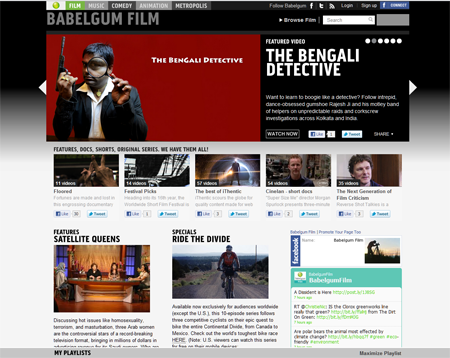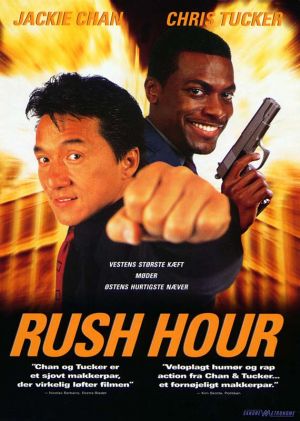Archive for November, 2010
Film Festival Reflection
I guess I’ll join in on the reflection posting party, let’s see if I can think of anything new …
Going into this festival, I wasn’t sure what to expect. No one in the class had experience (that they admitted to) putting on similar events (although, ahem, Galen, had super awesome reception planning skills and others, i.e. Jonathan, had experience with all the tech aspects), and we were working without the benefit of reflections from past semesters. I’m happy it all worked out in the end. I just wish, as it appears others in the class do as well, that we had managed to draw a larger audience.
In retrospect, I think it would have been useful to launch our promotional campaign earlier in the semester. Although I think we did a good job with targeted advertising, we did not do so well at blanketing the 5Cs with table tents, notices in the digesters, inclusion in Pomona’s “Weekender,” and so on. I would guess that many non-Asian, non-Queer Resource Center, non-media studies students didn’t know or remember about our event. Especially given how many different campuses are represented in the class, sheer coverage could have been better. Having more time to advertise would have been very useful, but if we had moved the festival to a later weekend we would have lost people to midterms, finals, and Thanksgiving break-related stress.
Instead of having the class divided into committees by screening, it might have been more efficient to have groups concentrating on specific tasks like general promotion, contacting student groups, reserving spaces, and planning reception(s). (I am very relieved and grateful that Prof. Ma handled contacting and staying in contact with the filmmakers.) On the other hand, getting the chance to do, or at least think about, a little of each was a great learning experience in terms of all the considerations that go into creating an experience for the audience.
It was wonderful hearing the different filmmakers’ perspectives on the nature of Asian American media. Our in-class working definition has been very inclusive: media created by Asian Americans and/or featuring Asians/Asian Americans and/or exploring Asian/Asian American issues. Like Ryan, I found it interesting that more than one filmmaker seemed irritated about or ambivalent towards being identified as Asian American makers of Asian American films, rather than simply “makers of independent films.” Despite the benefits of being able to draw on the resources and support of the Asian American community, being “pigeonholed” as Asian American filmmakers means that their films, regardless of their content, might never be considered completely mainstream. Their films are Asian no matter what and Asian doesn’t equal mainstream.
Should we have discussed playing down the fact that we were throwing an Asian American film festival and instead emphasized “free film screenings” in our advertising? Would that have served to subvert the exnomination of white in our thinking of filmmakers and film festivals? I’m inclined to believe it would have attacked a larger audience at least, but would that have destroyed the entire point of having an Asian American film festival? Food for thought for sure.
– Written and Posted by Alexis
Film Festival
Group Process?
There doesn’t really seem to be a way other then by means of a group process to tackle a film festival. Dividing the program into four separate themes (or two separate themes and two feature films) very much funneled the effort nicely. The film festival did remind me however, that no matter how the work is divided a select few will invariably turn into the true workhorses. In are case we were lucky that they were Jonathan, Galen and Prof Ma who each used their particular expertise well. I do worry that the opinions amongst the group or class were not as uniform as everyone would have let on but rather conformist. It’s tough to believe that the movie selecting process was as easy as it was if everyone was really honest. However this agreeableness most likely did not detract from the festival, the films although a compromise amongst members of the group, still varied in theme, tone, and subject
What did I learn?
Festival planning is a creative process. Therefore it is fundamentally not going to be a linear one. It’s wrong to assume that each day you will be one closer to a better festival. I also learned that in media it is especially easy to overstate or exaggerate how long something will take. It’s hard to gauge effort in a creative process but I don’t believe that planning the festival was particularly hard with the help of Prof. Ma, the IT from Pitzer, and a resourceful class.
Learn anything new about Asian Americans in Media?
I learned that when talking to a filmmaker its wrong to purpose them for my own ends. In other words, I question the morality of pigeon holing their film ethnically rather then by the merits of its own worth. I learned that race shouldn’t be part of genre and the diversity of the film’s shows how impossible that has become. “People I’ve Slept With” and “Raspberry Magic” couldn’t be more different. There should be less focus on who is making the film. I even started to wonder whether having an “Asian American” festival was appropriate. Doesn’t this just create a starch divided and assume ownership of the stereotype. In other words, maybe its wrong to create something and triumph it as a product of a particular race or culture. If nothing else, it cheapens what should stand on its own feet. Its easy and very Pitzer-like to say that these events are a chance to re-contextualize stereotypes but I don’t believe that to be true. Anything under that guise is simply a cop out for not only allowing but supporting things to be sorted by Race.
Anything surprise you?
I think its important to hold the festival during one free weekend and in one space. I imagine that localizing the event would create more of magnet for interested students. I don’t think Posters are good enough for an academic event. I think it is fitting that we ask professors to maybe talk it about in their class. I hope that we never use Skype again. Although that sort of presentation may one day be the future, right now, we may have been a little ahead of our time.
2010 Mini Festival of Recent Asian American Films Reflection (Jonathan Soon)
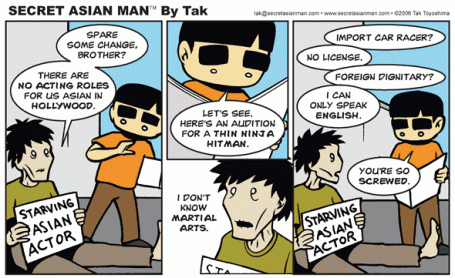
(Secret Asian Man by Tak Toyoshima)
- How did the group process work for you – are there things that you would do differently in retrospect? If so, why?
I think the group process worked well. There weren’t a lot of issues that truly caused controversy or a divide among the group, which always helps. I think deciding things with voting and having Prof. Ma mediate/moderate was a good way to do things.
- What did you learn from programming and organizing the Festival?
I learned a lot in both the programming and organization of the festival. From a programming standpoint I learned the different considerations in terms of not only format (serial vs. condensed) but also what actually goes into choosing a screening program from a pool. I learned that filmmakers get paid for their works to be screened and to appear in person. (This makes sense, but I have never really known about this or thought about it before.) From an organization standpoint, I learned a lot of technical skills. I learned how to use Adobe Illustrator to make a flier (I now know why people use this instead of Photoshop to make fliers). I also learned how to operate the audio/visual booth in Broad Performance Space. Finally, I got a glimpse into the lives of independent filmmakers of various notoriety at both the dinner and the reception we hosted. I enjoyed both and especially enjoyed chatting with Quentin Lee about various topics.
- Did you learn something new about the subject that is different from what you learnt in the books and films we discussed in class?
I thought it was interesting the festival featured both RASPBERRY MAGIC and THE TAQWACORES. Both these filmed featured groups I would normally not associate with an Asian American film festival. I also thought the subject matter covered in WIND IN A BOX and GRANDMA (transgenderism, mental health) are subjects that normally not discussed in Asian communities.
- Did your views on Asian American media change during the project?
I think my views changed in that I got to see some more modern independently produced Asian-American features and shorts. It definitely got me interested in the Los Angeles Asian Pacific Film Festival that is coming up next year. I think it’d be cool to volunteer but with classes that seems hard…I should hopefully be able to at least make some screenings. I enjoyed seeing Asian American in both somewhat stereotypical roles (but usually with a good twist) and roles they would normally not have. STRANGERS in particular is interesting because it’s an American movie, set in LA and is a thriller/action film with both an Asian male and Asian female lead and a Caucasian sidekick…normally it’s the other way around.
- Were there things that did not work, or ones that worked differently from what you expected?
One thing that I’m going to work on for all future projects is proofreading. Anytime you have text, it seems like no matter how many times your proofread there will still be errors unless you have like 3 other people read the same text. (“Rasberry Magic” comes to mind.) This blog post is no exception, I found 3+ typos in it even after proofreading it 5 times. I also think for future festivals that having a longer lead time would be better to allow for more people to be on panels and to allow for better promotion.
-Written and Posted by Jonathan Soon
Film festival reflection (Jasmine Kim)
How did the group process work for you – are there things that you would do differently in retrospect? If so, why?
It was extremely helpful to have everyone’s different opinions and assistance. Coming back to the group from working in partners was a time that enabled for sharing of ideas and suggestions. I was so impressed with the amount of work that each team accomplished. The programs that everyone organized were interesting and succeeded in engaging the audience. In retrospect, I think I would have tried to have more conversations with the rest of the class — whether through email or me getings outside of class-time.
What did you learn from programming and organizing the Festival?
I learned how difficult and time-consuming that organizing such a big event could be. But also how rewarding it could be. I’m really glad that Prof. Ma was able to play such a large role in the planning. It is extremely difficult to get in contact with so many filmmakers and choose a date that fits in with their busy schedules. But we were able to have 4 filmmakers participate in our programs.
Did you learn something new about the subject that is different from what you learnt in the books and films we discussed in class?
I really enjoyed the shorts program, Finding Our Voices. Not only because I helped organize it, but because it addressed an array of topics that we have not mentioned in class yet. Having Tani Ikeda, the director of Wind in a Box, and Mark Villegas, director of Lyrical Empire, was enlightening. They explained the background to their films that we lacked as viewers limited to our own interpretations.
Did your views on Asian American media change during the project?
Seeing the different works by recent Asian American filmmakers was inspiring and encouraging. The voice of the API community is growing and these films were only just a sample of what we can expect to see in the future.
Were there things that did not work, or ones that worked differently from what you expected?
I realized that the Q&A session could be so much more than just a few typical questions asked and answered, squeezed into a period of 5 to 10 minutes. Directors Mark Villegas and Tani Ikeda shared conversations/comments/questions about each other’s works at the front of the stage. The audience saw an interaction between two artists who appreciated each other’s works and learned so much more about the film/topic/process than we would have without it.
Film Festival Reflection
In reflecting on the Mini Asian American Film festival I am quite pleased at how the festival turned out. The group process was very successful. I enjoyed being able to focus on a particular program and work on it from start to finish rather than working a little bit on each one. Jasmine and I worked very well together on the shorts program; Finding Our Voices. We did a great job dividing up tasks like who would write the intro, the blurbs and the bios. In retrospect I think the only thing our class could have done better would have been to promote the festival more so that more people would show up. From programming and organizing the festival I learned the importance of communication not just within programming groups but between groups. I also learned that when putting together programming it’s important to have shorts that really go together and work around a central theme. It is one thing to watch films by Asian Americans in class and discuss all of the potential motives behind the film and what they might have been trying to accomplish but another to actually hear the real reasons from them first hand. One example of this that really struck me was listening to the writer of Raspberry Magic talk about how she wrote this movie because she hadn’t seen any real depictions of South Asians in mainstream media. I learned a lot about the process of filmmaking from the writers/directors/producers that joined us. It was really interesting and a little intimidating to hear about how expensive and difficult it is to finance a film. My views on Asian American media defiantly changed. Watching the movies in class and screening them on my own didn’t give me a sense of just how important independent filmmaking is. In my personal opinion even though it was not too difficult a transition moving from Broad Center to Benson I think it would have been nice to have the festival in one venue. I also think there was a bit too much time between screenings. Overall I was happy with how the festival went and all my friends who came really enjoyed it.
-written and posted by Megan Kilroy
Who Killed Vincent Chin? (1987)
Who Killed Vincent Chin? is a documentary film directed by Christine Choy and Renee Tajima-Pena. Tajima-Penais also the director of My America … or Honk if You Love Buddha (1997). She is the recipient of multiple awards and grants and is currently at UCSD now in the Communications Department. Choy is the chair of the Graduate Film and Television Department at the Tisch School of the Arts, NewYork University. The founding director of the School of Creative Media, City University of Hong Kong, and she is also the recipient of numerous awards.
Nominated for the 1989 Academy Award for Best Documentary, Who Killed Vincent Chin was well received by critics and was an important achievement for Asian American filmmakers. It is a very different kind of documentary from ones like Fall of I-Hotel (1983) in that it avoids a linear, straightforward presentation of case. Instead we have to piece together an understanding of how and why Vincent Chin died over the course of the entire film. In the reading we did for class[1] the Bill Nichols described it as Nachträglichkeit, or “willing backwards”,
A viewing experience that suspends us in time, between past, present and future [… it] stands distinctly apart from the form of historical consciousness arising from classic realist representation with its sense of linear causality and teleological determination. Here, by contrast, the future remains unknowable but simultaneously up for grabs.
It tries to convey the complexity of an event and how it would be impossible to represent all of it with only the bits and pieces that could fit into an 82-minute film. The format forces audiences to go through the process of constructing a coherent narrative out of all the information for themselves.
The film stands out for not only it’s place in the history of Asian American documentaries, but also because of the Asian American activist organizing it documented. The group, American Citizens for Justice was organized as a direct result of the community outrage.
The Asian American community became a united front during the trails of Ronald Ebens and Michael Nitz, wanting them to be punished for the civil rights violation they took part in. Many Asian Ethnic organizations worked together on the case and helped to organize rallies and speeches nationwide held in honor of Vincent Chin and in the interest in finding the justice he deserved. The murder ands subsequent trials are considered by many to be the starting point for a pan-ethnic Asian American movement and the documentation of this historically important moment should be recognized and honored.
– Alexis and Rebecca
[1] Nichols, Bill. “Historical Consciousness and the Viewer: Who Killed Vincent Chin?” Screen Asian Americans. Ed. Peter X. Feng. New Brunswick, NJ: Rutgers UP, 2002. 159-172.
The Future of Asian American Film Festivals (Film Festival Report Part 5)
So what exactly is the future of Asian American Film Festivals in today’s Internet driven postmodern world? This is obviously hard to foresee, but I think the Internet’s effect will generally be positive as it lowers the barrier of entry for media makers. As Jasmine has pointed out in her project, there is already a large Asian American presence on the Internet in the form of various videos hosted on sharing sites such as YouTube. Indeed the Internet has no true filter, so anything anyone produces can be uploaded, but the real question is whether or not anyone is watching. This lowered barrier of entry might lead to Asian American media being relegated to relatively small audiences. (The signal to noise ratio on the Internet is generally large.) Also media is not produced in a vacuum, so it is likely that artists in general will largely imitate was it popular and within their means. This can lead to a homogenization of media. One only needs to look at the top daily YouTube videos to see this. Many of the top videos are simply video blogs done in front of a green screen with amateur digital effects. However it should be noted this isn’t really that much different from what traditional Asian American media has dealt with. As Kayo Hatta said, “One of the frustrating things within the Asian American community sometimes can be that they don’t see something as worthwhile until it’s validated by the mainstream”[1]. So you could have a case where a given Asian American online video is not popular among the Asian American community until the wider Internet community votes it up on digg or shares it a lot on Twitter, etc.
Of course with any lowering of the barrier of entry comes additional criticism. Current Asian American media producers may feel threatened or dismiss the newcomers. The question of legitimacy will arise. I fail to see how this will have a significant impact in a media world where more and more people are consuming media online, whether that is via streaming or downloading. I believe in general the Internet public doesn’t think too deeply about how “legitimate” a given media maker or content provider is, they are just looking for entertainment. Indeed, the fact that a lot of online videos are made for embedding or messaging (email, facebook, twitter, digg, reddit, etc.) to one’s friends show this. And the recommendation of one’s friend is the best marketing a given work can hope for as it adds a personal touch. The Internet also provides for direct communication between media makers and consumers. This can lead to many interesting interactions, such as crowd sourcing the production of a given work or raising funds via online donations systems such as Kickstarter. It also will lead to immediate criticism, but once again criticism is not new to Asian American media. What is specific to Asian American media is that there will always be “cultural critics”, those who deem a work is “not ethnic enough” or “too ethnic”. They perform what Charlotte Brundson calls “redemptive readings”[2] which point out the inconsistencies in a given text to salvage the work for a particular audience. You can already see this at work when people criticize a work as not being ethnically accurate via online comments.
As stated in my previous post, I don’t think any online recognition can truly replace physical world recognition. Still, I think the idea of a “virtual” film festival is intriguing and I wonder if it only a matter of time before we see the idea take off. There are already some in existence and I am sure there will be more. Not only would a virtual film festival be cheaper than a real film festival, it is likely to represent the independent nature and grassroots, “do it yourself” mentality that has been the defining characteristic of the Asian American media movement since the 60s. Perhaps this is not such a weird idea after all.
-Written and Posted by Jonathan Soon
Why Asian American Film Festivals? (Film Festival Report Part 4)
 (from SHORTCOMINGS by Adrian Tomine)
(from SHORTCOMINGS by Adrian Tomine)
So what exactly is the point of Asian American Film Festivals? Why do they exist? And are they necessary in our post-modern, Internet driven, mobile media world? I argue that Asian American Film Festivals are still relevant today for various reasons.
The first is mainly historical. As we have seen in class, the Asian American media movement has always had its roots in the social and political movements of the 1960s (civil rights and ethnic studies respectively). The movement “developed its own agenda and aesthetic in opposition to [the] mainstream”[1] The result of this is the “anti-slick” look of many Asian American media of the time as well as the attempt to “abolish the division between art and life, between filmmakers and viewers”[2]. Thus modern Asian American works have their roots in media that are not something typically found in Hollywood, and not something that can really be consumed by a mass audience.
Enter the Asian American Film Festival. An Asian American Film Festival provides a venue for exactly the sorts of work that the Asian American community produces. Though they may have big corporate sponsors, the Film Festival circuit offers both media producers and consumers a taste of something different, something decidedly not Hollywood or mainstream. Asian American Film Festival often feature the first work of a rising star that later may go onto widespread mainstream success. Both Wayne Wang’s CHAN IS MISSING and Ang Lee’s thesis film were both screened at the Asian American International Film Festival in New York[3]. Asian American Film Festivals present characters, settings, and viewpoints from a culture that is critically underepresentated in mainstream media. I know in particular from our pool I was very impressed by Michael Aki’s STRANGERS, a neo-noir thriller with Asian male and female leads. I admit I am not used to seeing an American film where the two main leads are not only Asian, but their “Asianness” is not a factor (he is not a martial arts master, she is not a Lotus Blossom or Dragon Lady). I also loved how the comedic sidekick was Caucasian instead of an ethnic minority as it usually would be in an action/thriller film (RUSH HOUR comes immediately to mind).
I believe that even in today’s Internet driven world where people watch an increasing amount of media via the Internet and on mobile devices (including not just smartphones but tablets like the iPad) that Asian American Film Festivals are still important. This is because they provide legitimacy and physical recognition that the Internet can never provide. No matter how many subscribers a YouTube media producer may have, it does not compare to being able to do a Q&A in front of live people or hearing the physical applause in a theater after one’s work has screened. I believe most people would also view any media screened at a major Asian American Film Festival as “more legitimate” and “more prestigious” than a “random” online web video. While this may change in the future with award shows like The Streamys, I think we are still a decade or more off from this occurring.
-Written and Posted by Jonathan Soon
Running a Film Festival: Overview & Tips (Film Festival Report Part 3)
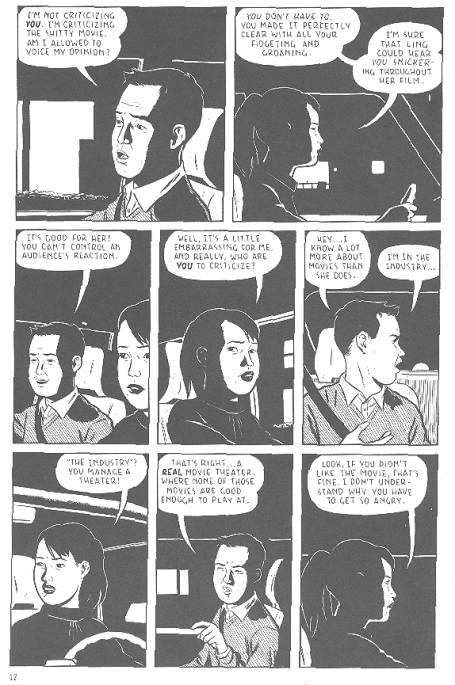
(from SHORTCOMINGS by Adrian Tomine)
The actual operations of a film festival are essentially like every other event; one must keep track off and complete a variety of tasks. Recall that Asian American Film Festival are generally staffed by volunteers (I know Visual Communications puts out a call for volunteers every year for the Los Angeles Asian Pacific Film Festival and are quite independent in terms of major media events (generally there are not tons of corporate sponsors unlike festivals such as Cannes or Sundance). Like many events in real life (Baby Shower, Wedding, Birthday Party), you really only get one shot at everything and any mistakes you make you will have to live with and dynamically adjust to. No even is perfect, but keep in mind any mistakes reflect poorly on both the event and and the planners (you). Some of the best remembered events actually had numerous problems/issues that were either resolved quickly or hidden by their organizers (I can speak from personal experience on this one as I’ve had to save events run by other people). Remember, in most cases individuals involved with the actual creation of the media will be present. You definitely do not want to be responsible for an event where someone feels their media was not shown in the best possible environment and at the best possible quality.

Still from Red Dust (2010)
For our film festival I took care of many of the technical aspects because I am a member of Pitzer IT as well as friends with the staff in Audio-Visual. I learned a lot working in the audio-visual booth of Broad Performance Space for both Love & Justice and Finding Our Voices. The most important thing I learned is that you absolutely, positively MUST have a backup copy of everything you are planning on screening. Without a backup copy of LT. WATADA, the screening would have ended up being a disaster as the screener copy we were sent had a scratch/stains on it that caused it to not play more than a few minutes. On a related note, actually testing the audio-visual equipment in the screening space is also important (though in the case of LT. WATADA this ended up giving us a false positive). I also learned that a flashlight is very handy for adjusting things in the screening space without turning on the lights. An assistant is also useful to monitor audio levels and tell you to raise or lower them and for when you need to go take a break for whatever reason (phone call, bathroom, etc.)
Of course just because I wasn’t as directly involved in the other aspects of a film festival does not make them any less important. Planning and executing the dinner might have been fairly easy because of the casual nature of the event (I loved the dinner), but the reception was another matter. Fortunately for us, Galen was able to get Bon Appetit to cater the event with delicious food. While all the hors d’oeuvres were delicious, I especially enjoyed the seared ahi tuna with wasabi one the most, a fact that is not lost on me given the Asian-American nature of our event (it was poetic I suppose?). I talked to several of our guests as well as other (not from the class) atneedees and they enjoyed the food and wine. Obviously spending the money to hire Bon Appetit to cater the event greatly reduced the amount of work we would have to do as we didn’t have to staff or bring the food ourselves.

(Q&A for Finding Our Voices)
Finally there’s one last aspect that should go without saying: be respectful of the guests. Make sure you know their names, and if you don’t find out before calling people “that guy” or “hey”. Offer to get them water or other refreshments you may have on hand. Lead them around the facility (the campus in our case) and make sure they know where the nearest restrooms are. Also make sure to introduce your guests and give a brief bio about each of them (I admit I fumbled this a bit in my intro but I’ve learned for the future!). Make sure to have a list of prepared questions you can ask during the Q&A to guide or “prime” the audience. (Generally after a few questions the audience is ready to ask their own.) Before the night is over, make sure you thank them for coming out. Yes they are technically getting paid to appear but (at least for our festival) it’s not much and they still took time out of their schedule to show up.
Planning & Programming (Film Festival Report Part 2)
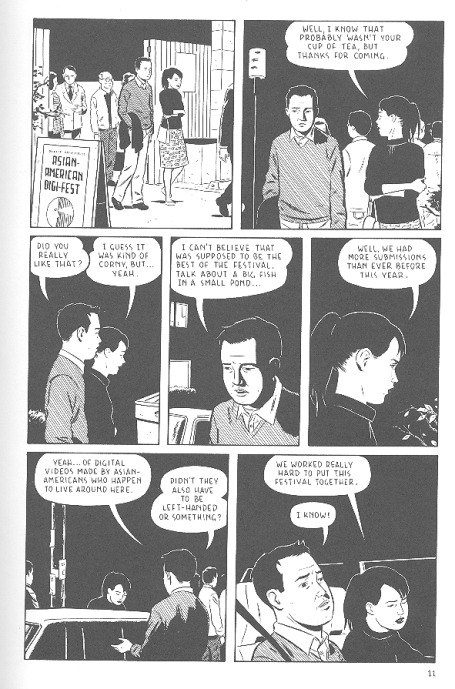 (from SHORTCOMINGS by Adrian Tomine)
(from SHORTCOMINGS by Adrian Tomine)
As our guest speaker Abe Ferrer (Co-Director of the Los Angeles Asian Pacific Film Festival) pointed out in his visit, film festivals choose from a huge pool of media for screening. Abe mentioned that for the Los Angeles Asian Pacific Film Festival there were hundreds of entries and he personally watched at least a part of 300 or so. The general process is there is a “call for submissions” during which virtually anyone can submit a work for screening consideration provided they meet eligibility requirements and pay a submission fee. The eligibility for an Asian American Film Festival usually requires that the film either be produced by Asian Americans, feature Asian American, and/or deal with topics related to Asian Americans. (Note the definition of “Asian Americans” can be quite broad or restrictive depending upon the festival.) A given festival may require only one of these aspects or all three. Both The San Francisco International Asian American Film Festival and the Los Angeles Asian Pacific Film Festival accept “films and videos that are made by or about Asian Americans and Asians of any nationality. All lengths and genres will be considered.” These are definitely quite broad eligibility requirements. Submission fees are usually graduated as well, there is an “early deadline” and a “late deadline” in terms of submission dates and submitters pay more if they submit after the “early deadline”. Note that the entry fees for Asian American film festivals are generally less than those of bigger, better known film festivals such as Sundance. The lower costs and wider eligibility requirements are necessary because of the nature of Asian American media: it is generally independently produced and often not feature length.
As Prof. Ma pointed out in his guidelines to our film festival, there are other criteria in play during the selection process than simply “Is [the work] well made?” There are issues of “breaking new ground” and whether or not a work speaks to the “Asian American experience”. Abe mentioned that a work can be somewhat un-polished or not super professional in technical terms, but will still get selected for their festival simply because it represents a new or seldom seen point of view. (RASPBERRY MAGIC and THE TAQWACORES immediately come to mind in the “new or seldom seen point of view” aspect.) Of course, a real film festival (unlike ours) has to sell enough tickets and secure enough sponsorship to at least break even assuming the festival organizers want to continue running it. This means picking some more mainstream polished works that will both please and attract a crowd. Festivals generally have a couple “big draw” films in big theaters and venues while the (theoretically) less popular shorts and experimental films get smaller venues. One good example of this is New York’s Asian American International Film Festival, which screened PEOPLE I’VE SLEPT WITH as the Closing Night Presentation. We also screened this film as our last program as the class felt it was a “crowd pleasing” movie and an “easy sell”.
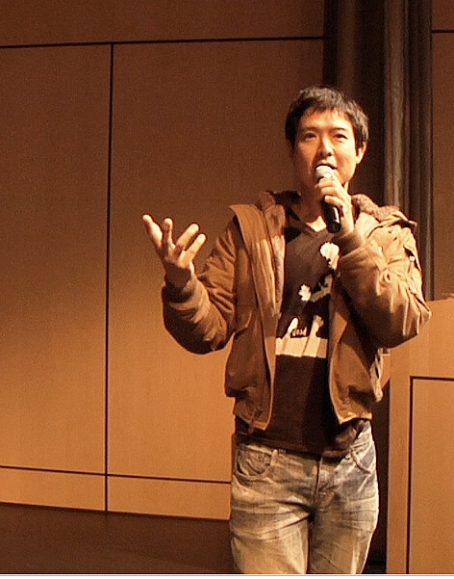 (Quentin Lee taking questions)
(Quentin Lee taking questions)
As we found out first hand, there is one additional aspect during film festival programming that cannot be overlooked: scheduling. Not only in terms of securing venues and equipment to actual screen works, but the schedules of the filmmakers must be taken into consideration as well. The main draw of a film festival is that after a screening various members of the cast and crew are present for a question and answer panel. This usually includes the director, producer, and a lead actor or more of the cast. Obviously the film festival’s screening times must be such that cast and crew can attend. We selected our films and shorts based on not only class voting but whether or not the filmmakers could make a Q&A panel afterwards. (We even used Skype to talk to the producer and director of RASPBERRY MAGIC.)
Finally there is the serial vs. compressed format issue. A serial format is one where a work is screened on a certain day at a specific time for a given amount of weeks. (Last year’s festival for this class was used this format; works were shown every Thursday at 7PM for 4 weeks straight.) The compressed format is something akin to a convention, works are screened continuously throughout the day (space and time permitting) and each day has its own set of screening. The vast majority of film festivals are of the compressed format. Every festival mentioned so far in this post, including Sundance, uses the compressed format. One generally sees a serial format at places such as universities or independent theaters that will do a film series such as “noir night” every Thursday in November. One good example of this is the Silent Movie Theater, which (true to its name) screens a silent movie every Wednesday among other programs.

